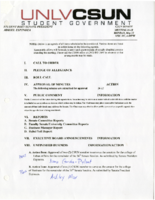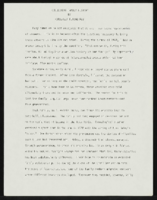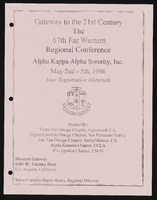Search the Special Collections and Archives Portal
Search Results

Meeting minutes for Consolidated Student Senate, University of Nevada, Las Vegas, May 22, 2006
Date
Archival Collection
Description
Text

Meeting minutes for Consolidated Student Activities Board, University of Nevada, Las Vegas, September 25, 1978
Date
Archival Collection
Description
Text

Meeting minutes for Consolidated Student Senate, University of Nevada, Las Vegas, October 10, 1978
Date
Archival Collection
Description
Text

Meeting minutes for Consolidated Student Senate, University of Nevada, Las Vegas, February 09, 1982
Date
Archival Collection
Description
Text

"Collecting Family History": article draft by Roosevelt Fitzgerald
Date
Archival Collection
Description
From the Roosevelt Fitzgerald Professional Papers (MS-01082) -- Drafts for the Las Vegas Sentinel Voice file. On Black families in the United States and family reunions.
Text

Alpha Kappa Alpha Sorority 67th Far Western Regional conference program
Date
Archival Collection
Description
From the Alpha Kappa Alpha Sorority, Incorporated, Theta Theta Omega Chapter Records (MS-01014) -- Chapter records file.
Text

Transcript of interview with Jonathan Sparer by Stefani Evans and Claytee White, August 29, 2016
Date
Archival Collection
Description
Text

Transcript of interview with Juan Saa by David G. Schwartz, November 21, 2016
Date
Archival Collection
Description
Text

Congregation Ner Tamid roundtable oral history interview: transcript
Date
Archival Collection
Description
Oral history interview with the Congregation Ner Tamid roundtable conducted by Barbara Tabach on September 21, 2016 for the Southern Nevada Jewish Heritage Project. In this interview, Rabbi Sanford Akselrad and five members of the congregation discuss the founding of Congregation Ner Tamid, the first reform synagogue in Las Vegas, Nevada, in 1974. They go into detail on how the synagogue was formed, the building-hopping they did until they built their current structure, and the funding it took to get to that point. The interviewees reveal a few donors, such as Morris Dalitz and Frank Sinatra, who helped to build their synagogue and school. The interview ends with meaningful stories and memories the members have relating to Congregation Ner Tamid.
Text
Bezard, Pierre, 1924-2020
"Pierre was born June 16, 1924 in Paris, France. He survived WWII as a prisoner in a Nazi work camp where he met his lifelong friend Louis Juif. After the war, he returned to his family and began his career working backstage in theater. Although he never had much formal education, Pierre quickly ascended to the position of stage director, managing numerous productions including the Lido in Paris, Casino de Paris in Las Vegas, Ballet de Roland Petit, Solid Gold Las Vegas, Vive Les Girls, as well as touring shows worldwide.
Person
